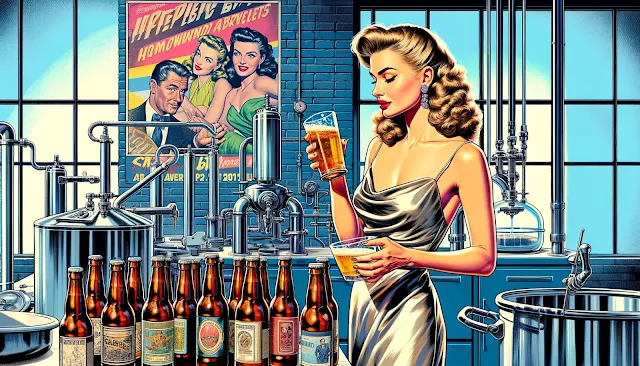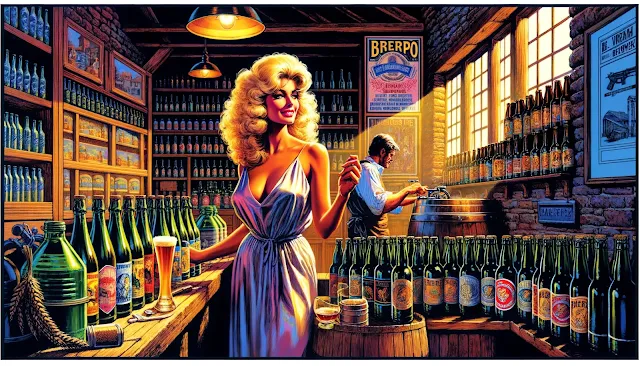The craft of homebrewing beer is an art form that marries science with creativity, yielding delicious and unique results that can be shared and savored.
However, the journey from brewing to enjoying a homebrewed beer does not end with bottling.
Good lord, we're only in the first 100 yards of this 400 yard dash!
Why?
Because, dearest Padawan, we need to let secondary fermentation to occur and let the beer settle and 'mellow' out so it becomes drinkable.
'Bottle conditioning' is a critical step that ensures the quality, flavor, and longevity of the beer remain intact until it is ready to be enjoyed.
Let's regardez the essential aspects of storing bottled homebrew beer, aiming to equip brewers with the knowledge needed to preserve their craft optimally.
Understanding the Importance of Proper Beer Storage + Conditioning
The shelf life and quality of homebrewed beer can be significantly impacted by several factors, making proper storage a critical consideration for any brewer.Temperature, light, oxygen, and humidity each play a pivotal role in the preservation of beer. Incorrect storage conditions can lead to a variety of undesirable outcomes, including off-flavors, oxidation, and spoilage, which compromise the beer's intended taste and aroma.
Temperature fluctuations can cause beer to age prematurely, while excessive heat can lead to the development of stale flavors. Light, particularly ultraviolet (UV) light, can react with hop compounds in beer, resulting in a skunky off-flavor known as "lightstruck."
Temperature fluctuations can cause beer to age prematurely, while excessive heat can lead to the development of stale flavors. Light, particularly ultraviolet (UV) light, can react with hop compounds in beer, resulting in a skunky off-flavor known as "lightstruck."
Oxygen exposure post-bottling can lead to oxidation, which manifests as cardboard-like or sherry-like flavors, diminishing the beer's freshness. Lastly, humidity levels can affect the physical condition of the beer's packaging, potentially leading to label damage or mold growth, and in extreme cases, may even influence the beer's taste.
Choosing the Right Storage Location
Selecting an ideal storage environment is paramount for extending the life of bottled homebrew beer and preserving its quality. The perfect storage location should offer stability in temperature, minimal light exposure, and adequate ventilation to prevent the accumulation of any odors that could permeate the beer. Common choices include cellars, closets, or a dedicated refrigerator, each offering unique benefits and considerations.Cellars often provide a naturally cool and stable temperature, making them ideal for long-term storage. Closets, especially those located in the interior of a home away from sunlight, can offer a dark and stable environment. Dedicated refrigerators allow for precise temperature control, which is particularly beneficial for storing beer at the optimal range for its style.
When selecting a storage location, it's essential to evaluate these factors in the context of the available spaces within one's home, aiming for a balance between practicality and ideal storage conditions.
The art of Temperature Control
Maintaining a consistent and appropriate temperature is crucial for the proper storage of bottled homebrew beer.
The optimal temperature range varies depending on the beer style but generally falls between 45°F to 55°F (7°C to 13°C) for most types. This range helps slow the aging process, preserving the beer's original flavors and aromas for longer periods.
To control temperature fluctuations, brewers can use various strategies such as insulating the storage area, placing bottles away from heat sources, and avoiding areas subject to temperature swings, such as garages or attics. For those with access to a dedicated refrigerator or temperature-controlled cellar, setting and monitoring the temperature can ensure the beer remains within the desired range, safeguarding against the risks posed by extreme temperatures.
To control temperature fluctuations, brewers can use various strategies such as insulating the storage area, placing bottles away from heat sources, and avoiding areas subject to temperature swings, such as garages or attics. For those with access to a dedicated refrigerator or temperature-controlled cellar, setting and monitoring the temperature can ensure the beer remains within the desired range, safeguarding against the risks posed by extreme temperatures.
Minimizing Light Exposure to Green Bottles
The damaging effects of light on beer in green bottles are well-documented, with UV rays causing hop compounds to break down and produce unpleasant flavors.This is sometimes known as skunked beer.
Using dark-colored bottles is a straightforward approach, as these bottles filter out harmful UV rays more effectively than clear or green bottles. Alternatively, storing beer in opaque containers or in areas devoid of natural and artificial light can provide an additional layer of protection.
Ensuring that the storage location remains dark or is shielded from direct light exposure is key to preserving the beer's intended flavor profile.
Preventing Oxidation and Contamination
Oxidation and contamination are among the primary concerns when storing bottled homebrew beer, as both can significantly detract from the quality and enjoyment of the final product. Oxygen exposure after bottling can lead to oxidation, characterized by stale, cardboard-like flavors, while contamination from bacteria or wild yeast can result in off-flavors and spoilage.To minimize the risk of oxidation, it is crucial to ensure that the beer is properly sealed. Using high-quality caps and ensuring they are securely crimped onto the bottles can help prevent oxygen ingress. Additionally, filling bottles to the appropriate level, leaving minimal headspace, can reduce the amount of oxygen in the bottle post-sealing.
For those looking to further minimize oxygen exposure, investing in oxygen-absorbing caps can offer an added layer of protection.
Sanitization practices play a vital role in preventing contamination. All equipment used in the bottling process, including bottles, caps, and any transfer tools, should be thoroughly sanitized before use. This helps eliminate potential contaminants that could spoil the beer or alter its intended flavor profile. Consistent and rigorous sanitization ensures that the beer remains pure and enjoyable, reflecting the brewer's intended craftsmanship.
Sanitization practices play a vital role in preventing contamination. All equipment used in the bottling process, including bottles, caps, and any transfer tools, should be thoroughly sanitized before use. This helps eliminate potential contaminants that could spoil the beer or alter its intended flavor profile. Consistent and rigorous sanitization ensures that the beer remains pure and enjoyable, reflecting the brewer's intended craftsmanship.
Managing Humidity Levels
Humidity control is an often-overlooked aspect of beer storage, yet it plays a significant role in preserving the condition of the beer's packaging and, by extension, the beer itself. Excessive humidity can lead to label peeling, cap rusting, and in severe cases, mold growth, which can compromise the seal and lead to contamination.To manage humidity levels effectively, brewers may consider using dehumidifiers or desiccants in the storage area, especially if it is prone to high humidity.
Monitoring humidity levels with a hygrometer can help brewers maintain an optimal range, generally between 50-70% relative humidity. This balance prevents the adverse effects of both excessive moisture and overly dry conditions, ensuring the packaging remains intact and the beer's quality is not compromised.
If your beer shed is nice and dry, this should not be a concern for you matey.
Long-Term Storage Considerations
For enthusiasts interested in aging or cellaring their homebrewed beer, understanding the nuances of long-term storage is key to achieving desired results. Aging beer can enhance its complexity and depth of flavor, but it requires careful consideration of conditions, timelines, and suitable beer styles.Optimal aging conditions mirror those of standard beer storage but with an emphasis on stability over extended periods.
Temperature control remains crucial, with slight variations depending on the style being aged.
Aging dark beers like stouts and ales
Store the bottles in a cool, dark location with consistent temperatures, ideally between 60-70°F (15-21°C), to encourage yeast activity and flavor development without promoting off-flavors or excessive yeast growth. Unlike with lighter beers, slightly warmer temperatures can benefit the yeast metabolism in darker beers, enhancing the complexity of flavors over time.
Allow the bottles to condition for at least two weeks to several months, depending on the desired level of carbonation and flavor development.
Once the desired carbonation level and flavor profile are achieved, store the bottles upright in a cool, dark place for long-term aging and enjoyment.
Dark beers, such as stouts and heavy ales, often benefit from a longer period of aging, as it allows complex flavors to meld and develop, resulting in a richer and more nuanced drinking experience.
How to bottle condition lagers + pilsners
To effectively store lagers and pilsners during bottle conditioning, it's crucial to maintain consistent temperature and light conditions. Store the bottles in a cool, dark environment, ideally around 45-55°F (7-13°C), to facilitate proper carbonation and maturation of flavors without the risk of off-flavors caused by temperature fluctuations.
How to bottle condition lagers + pilsners
To effectively store lagers and pilsners during bottle conditioning, it's crucial to maintain consistent temperature and light conditions. Store the bottles in a cool, dark environment, ideally around 45-55°F (7-13°C), to facilitate proper carbonation and maturation of flavors without the risk of off-flavors caused by temperature fluctuations.
Additionally, ensure the bottles are stored upright to minimize yeast sediment disturbance, allowing for clearer beer when poured. It's beneficial to let the bottles condition for several weeks to months, depending on the specific beer style and desired flavor profile. Regularly monitor the carbonation progress by gently opening a bottle to check for the desired level of carbonation before fully enjoying the brew. Think of it this way. You should bottle your beer, read a novel from the Dune universe, an then come back to your brew.




